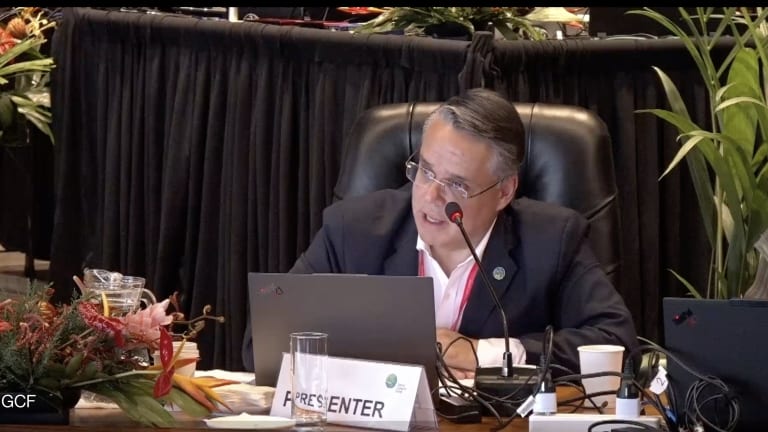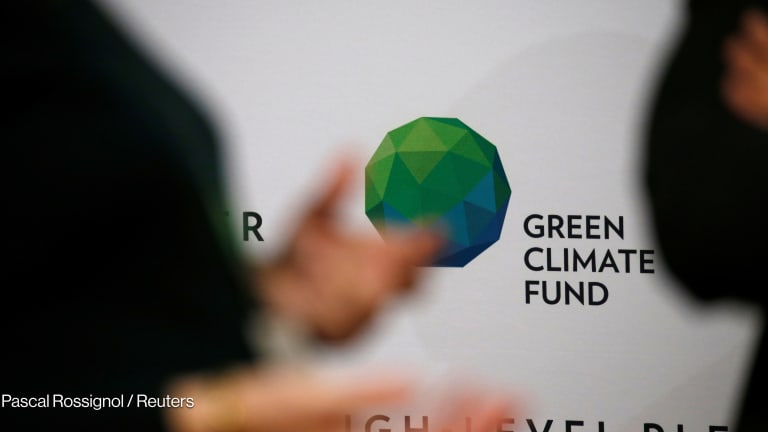The Green Climate Fund strives for a more catalytic role
Trillions are needed for the climate transition, yet the world's largest climate fund dedicated to helping low- and middle-income countries has a portfolio of only $11.3 billion. It wants to use this money in a more strategic way to unlock private capital.
The demand for climate finance is colossal, but supply is meager, so the Green Climate Fund is working to use its funds more strategically to unlock private finance. “We are seeking to be more catalytic,” Simon Wilson, acting chief of staff in the office of the executive director, told Devex on the sidelines of the 27th United Nations Climate Change Conference, or COP 27, in Sharm el-Sheikh, Egypt. “How do we use those funds in a smart way to bring in more partners — to drive in more funding?” The annual investment needed in emerging markets and low- and middle-income countries, apart from China, for emissions reductions, resilience building, nature restoration and loss, and damage impacts is expected to surpass $2 trillion by 2030. But the Green Climate Fund, which is the world's largest climate fund dedicated to helping low- and middle-income countries, is managing a minimal percentage of the overall sum of what is needed. Gearing up for replenishment The fund was set up by the United Nations Framework Convention on Climate Change in 2011 and works to achieve the goals of the Paris Agreement, with a 24-seat board made up of countries — half of which are high-income countries, and the other half low- and middle-income countries. Wilson described the fund as “capital agnostic” in that it uses a host of financial instruments — such as grants, concessional debt, equity, and guarantees — and doesn’t have a targeted rate of return nor a credit rating to defend. In this four-year funding cycle, the fund had about $10 billion at its disposal for programming — and has a portfolio of $11.3 billion. Next October, it will host a replenishment conference for its third round of funding through 2027. The fund doesn’t have a specific goal for the replenishment, but Wilson said demand for funds outstrips supply. Last year, the fund programmed $2.9 billion worth of new projects during its three annual board meetings. Wilson said under its current business model, it could do about double that, if resources were available. The fund receives public sector funding primarily from higher-income nations. It currently doesn’t have policies in place to accept funding from other sources, as its governance structure is composed of nations. This differs from the Global Fund to Fight AIDS, Tuberculosis and Malaria, for example, which has some non-governmental contributors on its board. It has a small secretariat — around 300 people based in South Korea. For the most part, the funding doesn’t allocate funding to country governments, but on a project basis — with about half of the funds focused on mitigation and the other on adaptation. It has a network of 114 project partners — or accredited entities — that range from big multilateral development banks, U.N. agencies, commercial banks, non-governmental organizations, and civil society organizations, among others. The fund works with the World Bank, for example, in structuring larger funds, of which the fund co-finances. Projects are submitted to the fund by accredited entities, which are reviewed by an independent panel, and approved during board meetings. Country governments can receive financing to strengthen capacity so that the countries can access larger sums of project funding. A country can receive up to $1 million a year of this grant funding that is specifically for strengthening capacity, which the government can also use to help build capacity of organizations it wants accredited for project implementation. Additionally, countries can receive $3 million towards the development of a long-term adaptation plan. A catalyst The fund wants to increasingly serve as a “convener of different partners” so that it can use its limited finance in ways that encourage the private sector to also invest in climate projects, Wilson said, adding that it is focused on unlocking new green markets and creating new asset classes. It wants to focus on additionality, meaning the fund steps in to finance a project when nobody else will, maybe because of perceived risk. When talking about serving a catalytic role, Wilson said, this doesn’t mean co-financing — the idea of different partners putting money on the table to reach a deal. The fund is setting up green bonds for the Caribbean, for example, in Jamaica. “Can we create green bonds that could be commercially viable?” Wilson asked. “Nobody really wants to do that first. We can do it first.” Similarly, on the equity side, the fund invested $125 million to establish a Global Fund for Coral Reefs with an equity investor. The fund will invest in private sector initiatives to protect coral reefs, which could include projects in sustainable tourism, fisheries, and coastal protection. “We want to prove that it's a realistic investment to actually protect coral reefs,” he said. If successful, people globally can invest part of their pensions in a portfolio focused on protecting coral reefs, which would basically create a new asset class, he said. These types of projects might not exist now because the market is fragmented, too small, perceived as too risky, or there is not enough demand. “If we invest this much here, can we unlock opportunities for others to come in and unfold a multitude of times that original investment? We then take our money out, put it somewhere else, and that project continues and grows,” he said. The fund launched during COP 27, in partnership with Egypt’s government, the first national Climate Investment Plan. Countries develop nationally determined contribution plans, where they lay out their plans for mitigating emissions. It’s essentially a “wish list” of demands or political targets, Wilson said, but the challenge is making them operational. “One of our jobs is to turn that into a bankable list of projects, which then our accredited entities could actually finance,” he said. This initiative will serve as a pilot, he said, with the fund playing a role in financing, but also in convening partners and structuring projects. The fund’s board has directed the fund to increase resources funneled into the private sector and COP 27 is a deal-making opportunity for the fund, Wilson said, to advance project proposals through meetings with partners. The fund is also a product of the Conference of Parties, so it reports back each year during the conference on its operations. COP, in turn, gives the fund guidance, which could include direction on the ways it should tweak the allocation of resources. The stumbling blocks A critique lobbied at the fund is that accessing funds is overly bureaucratic for fragile states, preventing them from accessing adequate levels of financing. Wilson said solving this problem is a top priority of the fund — but right now it doesn’t have the answers. “But we are willing to work on that and try and find better ways to work in fragile states,” he said. Wilson said that many of the conversations the fund is having with countries at COP 27 focus on debt burdens and working to find ways to fund climate activities in a way that doesn’t result in increased levels of unsustainable debt for countries. “We have some solutions to that, but we're trying to find others,” he said. The fund is also working to find more sophisticated ways of measuring impact.
The demand for climate finance is colossal, but supply is meager, so the Green Climate Fund is working to use its funds more strategically to unlock private finance.
“We are seeking to be more catalytic,” Simon Wilson, acting chief of staff in the office of the executive director, told Devex on the sidelines of the 27th United Nations Climate Change Conference, or COP 27, in Sharm el-Sheikh, Egypt. “How do we use those funds in a smart way to bring in more partners — to drive in more funding?”
The annual investment needed in emerging markets and low- and middle-income countries, apart from China, for emissions reductions, resilience building, nature restoration and loss, and damage impacts is expected to surpass $2 trillion by 2030. But the Green Climate Fund, which is the world's largest climate fund dedicated to helping low- and middle-income countries, is managing a minimal percentage of the overall sum of what is needed.
This story is forDevex Promembers
Unlock this story now with a 15-day free trial of Devex Pro.
With a Devex Pro subscription you'll get access to deeper analysis and exclusive insights from our reporters and analysts.
Start my free trialRequest a group subscription Printing articles to share with others is a breach of our terms and conditions and copyright policy. Please use the sharing options on the left side of the article. Devex Pro members may share up to 10 articles per month using the Pro share tool ( ).
Sara Jerving is a Senior Reporter at Devex, where she covers global health. Her work has appeared in The New York Times, the Los Angeles Times, The Wall Street Journal, VICE News, and Bloomberg News among others. Sara holds a master's degree from Columbia University Graduate School of Journalism where she was a Lorana Sullivan fellow. She was a finalist for One World Media's Digital Media Award in 2021; a finalist for the Livingston Award for Young Journalists in 2018; and she was part of a VICE News Tonight on HBO team that received an Emmy nomination in 2018. She received the Philip Greer Memorial Award from Columbia University Graduate School of Journalism in 2014.








